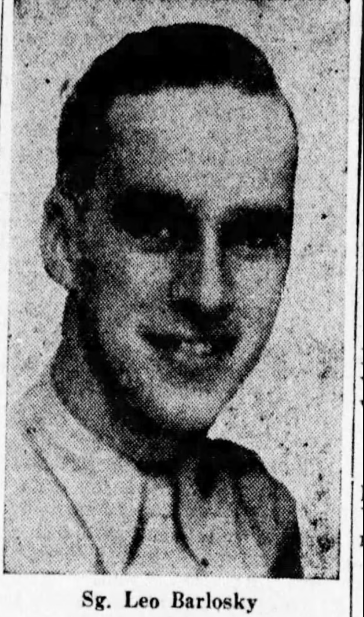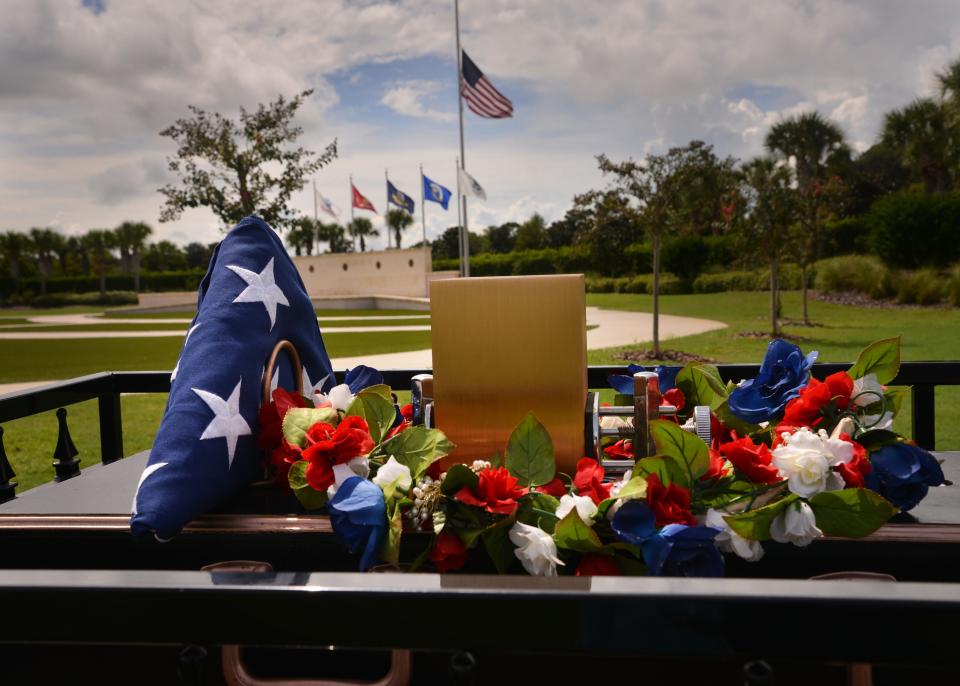Grace Recor never got the chance to meet her uncle, U.S. Army Cpl. Leo J. Barlosky — “my mother only told us that he went to war and didn’t come home.”
As a captured young soldier during World War II, Barlosky was forced to endure the horrors of the Bataan Death March in the Philippines, mere months after the Japanese surprise attack on Pearl Harbor. He was only 24 when he died of diphtheria at an enemy prison camp on July 27, 1942, and he was buried in a common grave.
Barlosky’s body was not identified after WWII ended. And he remained unaccounted for on the other side of the planet for generations. But in a September 2022 breakthrough, Defense POW/MIA Accounting Agency laboratory analysis identified the Pennsylvania native’s remains.
Tuesday — more than 82 years after his death — Barlosky was finally laid to rest with military honors during a funeral service at Cape Canaveral National Cemetery in Mims.
Honoring veterans: ‘Of solemnity’: Mims couple guides mule-drawn caisson at Cape Canaveral National Cemetery
Recor was not born until 1947, five years after her lost uncle’s death. But the Apopka resident felt a rush of emotion last week while watching a plane carrying his casket taxi up to the passenger terminal at Orlando International Airport.
“They had the color guard, and the fire department came and they did the arches over the airplane with the water cannon. It was really, really something to see,” Recor recalled.
“And I didn’t think I was going to get so emotional, but I did. I don’t … you know, it just like overcame me, I guess,” she said.
Death at age 24 in a Philippines prison camp

Born in February 1918 in Audenried, a village in east-central Pennsylvania, Barlosky had served in the Army for six years in Maryland; Savannah, Georgia; and Manila before he was assigned to the Philippines with the 7th Chemical Company, Aviation, The Hazelton (Pennsylvania) Plain Speaker newspaper reported.
Invading Japanese forces started pouring into the Philippines immediately after the Pearl Harbor attack, and U.S. and Filipino troops were forced to surrender in April 1942 after months of intense fighting. That’s when 60,000 to 80,000 American and Filipino POWs on the Bataan peninsula were forced to march about 65 miles — and subjected to ghastly war crimes, the National WWII Museum reported.
“The Bataan Death March is remembered as an absolute tragedy. The prisoners of war were forced to march through tropical conditions, enduring heat, humidity, and rain without adequate medical care. They suffered from starvation, having to sleep in the harsh conditions of the Philippines,” the museum website said.
“The prisoners unable to make it through the march were beaten, killed, and sometimes beheaded,” the website said.
Barlosky was imprisoned in inhumane conditions at the Cabanatuan POW camp in the Philippines, where the American death march survivors were confined. He was first reported missing in action on May 7, 1942, The Plain Speaker reported.
“An estimated 3,000 prisoners died or were killed during the march. And as many as 26,000 prisoners who made it to camp later died of starvation and disease, like Cpl. Leo J. Barlosky,” Rev. J.B. Kump, a retired U.S. Air Force lieutenant colonel and minister at Great Outdoors Community Church in Titusville, said during Barlosky’s eulogy.
Identified by Defense POW/MIA Accounting Agency


A timeline of events after Barlosky’s death, according to his Army personnel file:
-
1942: Barlosky is buried in Common Grave 225 at the Cabanatuan prison camp cemetery.
-
After WWII: American Graves Registration Service personnel exhume the cemetery and move remains to a temporary U.S. military mausoleum near Manila.
-
1947: AGRS personnel attempt to identify remains from Common Grave 225. Barlosky and others are buried at the Manila American Cemetery and Memorial as “unknowns.”
-
2018: Remains associated with Common Grave 225 are disinterred and sent to the Defense POW/MIA Accounting Agency laboratory for study at Joint Base Pearl Harbor-Hickam in Hawaii.
-
2022: DPAA officials identify Barlosky’s remains.
“I thank the government for remembering the heroes. And still looking for them, to recover them to bring them home,” said Gail Utitus. Her husband, Martin, is Barlosky’s nephew. The couple traveled from Milford, Connecticut, to attend Tuesday’s memorial service.
Barlosky is memorialized on the Walls of the Missing at the Manila American Cemetery in the Philippines. He had married his wife, Martha, while he was serving in Savannah, the Plain Speaker reported.
‘They answered the call to save the world’


Tuesday afternoon, Barlosky’s memorial procession led from North Brevard Funeral Home along U.S. 1 to Cape Canaveral National Cemetery. Dozens of well-wishers waved and held American flags along the route, including a large continent outside American Post Legion 1.
At the national cemetery, a black powder-coated caisson pulled by a pair of mules delivered Barlosky’s remains to Committal Shelter 2, where more than 60 mourners gathered for his funeral service. The mules were driven by Mims residents Tom and Denise Fitzgerald, who have escorted more than 700 veterans and first responders since 2018.
During his remarks, Kump hailed Barlosky as a hero of America’s Greatest Generation.
“These men and women came of age in the Great Depression, when economic despair hovered over the land like a plague. They had watched their parents lose their businesses, their farms, their jobs and their hopes. They had learned to accept a future that played out one day at a time. Then — just as there was a glimmer of economic recovery — war exploded across Europe and Asia,” he said.
Kump counted Barlosky among countless young men who left ranches in South Dakota, “main street” jobs in Georgia, assembly lines in Detroit and the ranks of Wall Street to serve their nation. Quoting Tom Brokaw’s book “The Greatest Generation,” Kump said, “they answered the call to help save the world from the two most powerful and ruthless military machines ever assembled — instruments of conquest in the hands of fascist maniacs.”
“We are fortunate that the untiring efforts of the U.S. military over all of those years to identify and return the remains of this American warrior allow us now to give him final honors, and to demonstrate our gratitude for his service on behalf of the family and the American people,” Kump told the audience, concluding his remarks.
“For now, Cpl. Barlosky is home at last.”
Rick Neale is a Space Reporter at FLORIDA TODAY. Contact Neale at Rneale@floridatoday.com. Twitter/X: @RickNeale1
This article originally appeared on Florida Today: ‘He went to war and didn’t come home’: Lost WWII POW buried in Florida
